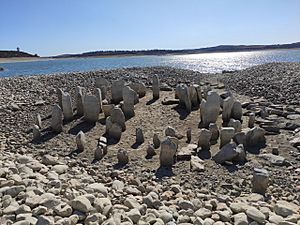Dolmen of Guadalperal facts for kids
The Dolmen of Guadalperal is an amazing ancient stone structure in Spain. Some people call it the "Spanish Stonehenge" because it looks a bit like the famous Stonehenge in England. This huge monument was built a very long time ago, between 2000 and 3000 BC. That's over 4,000 years ago!
You can find the Dolmen of Guadalperal near a town called Peraleda de la Mata in Extremadura, Spain. It sits inside the Valdecañas reservoir, which is a big lake on the Tagus River. Because it's in the water, you can only see it when the water levels are very low, usually during droughts.
Contents
What is the Dolmen of Guadalperal?
A dolmen is a type of megalithic monument, which means it's made from very large stones. The Dolmen of Guadalperal has about 150 granite stones. These stones, called orthostats, stand upright to form a round room about 5 meters (16 feet) across.
Before this room, there's a long hallway or corridor. This path is about 21 meters (69 feet) long and 1.4 meters (4.6 feet) wide. At the entrance to the main room, there's a tall stone called a menhir. It's about two meters (6.5 feet) high.
Special Carvings
This menhir has special carvings on it. Some people think the carvings look like a snake and several cups. Others believe the long, wavy carving might show the Tagus River as it flows through the area. These carvings might have been placed there to protect the site.
The main stone room was once covered with a mound of earth and gravel. It was also surrounded by another circular ring of stones.
Who Built It and Why?
Archaeologists believe the Dolmen of Guadalperal was used for different purposes. It might have been a special place for worshipping the sun, like a solar temple. It was also used as a burial site for ancient people.
In 1926, a German archaeologist named Hugo Obermaier discovered the monument. He led a team that studied the site between 1925 and 1927. They found some interesting things nearby.
They found Roman items like a coin and pieces of pottery. This suggests the site was still important even thousands of years later. They also found tools like axes, flint knives, and a copper punch.
Obermaier's team also found signs of an ancient settlement nearby. This was likely where the people who built the dolmen lived. They found old houses, charcoal, ash, and tools for grinding grain and sharpening axes.
Why is it called the Spanish Stonehenge?
The Dolmen of Guadalperal is sometimes called the "Spanish Stonehenge" because it's a large, ancient stone circle, much like the famous Stonehenge in England. Both are mysterious monuments built by people long ago. They show how ancient cultures used huge stones to create important places.
The Dolmen Under Water
In 1963, a big dam was built, creating the Valdecañas reservoir. This reservoir covered the Dolmen of Guadalperal with water. So, for many years, the monument was hidden beneath the lake.
However, when there are long periods of dry weather, the water level in the reservoir drops a lot. During these droughts, the Dolmen becomes visible again. This has happened several times in recent years.
Being underwater for so long has caused some damage to the dolmen's stones and their carvings. The water has slowly worn them away. Because of this, some groups are asking for the monument to be moved to a safer, dry place to protect it.
In July 2019, a satellite photo from NASA showed the Dolmen completely visible for the first time in about 50 years. This happened because of a severe drought.
Images for kids
See also
 In Spanish: Dolmen de Guadalperal para niños
In Spanish: Dolmen de Guadalperal para niños





